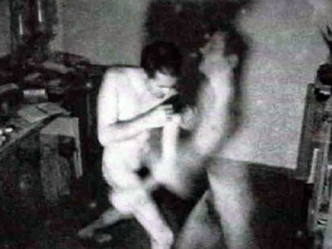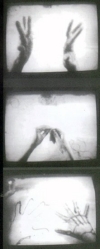Banner stills L to R: Somnambulists, courtesy Filmoteka Muzeum; Drawings, courtesy Vladimír Havrilla and Boris Kršňák;
Transformations: Potter's Bull, courtesy DEFA Film Library at the University of Massachusetts Amherst
Boxing
Ion Grigorescu, Romania, 1977, 8 mm transfer to 16 mm, 2 minutes 45 seconds

Still from Boxing, courtesy Museum of Modern Art, New York
Ion Grigorescu (b. 1945), who was trained as a painter but is best known today for his work in film, photography, and installation, has been one of the most influential figures in Romanian unofficial art since the 1970s. He has received this retroactive recognition even though the work he created before the collapse of Nicolae Ceauşescu’s dictatorial regime in 1989 was made in private for the consumption of a small circle of friends.[1] Working in this way, Grigorescu enacted in his apartment a series of solo performances as part of “a process of self discovery” that he photographed and filmed. Boxing belongs to this group of works and exemplifies both Grigorescu’s tendency to perform fully nude and his ability to use the camera’s technical capacities to create allegorical meanings for his stripped-down acts. In Boxing, he double exposed footage of himself throwing punches in two opposite directions to produce the appearance of the artist having a boxing match with a ghostly version of himself.
Writing in the catalog of a Grigorescu retrospective titled In the Body of the Victim, Joanna Mytkowska and Marta Dziewanska note the artist’s “radical consolidation of artistic activities with quotidian life” and contend that “Grigorescu’s oeuvre can be seen as a classic example of Central European experimental art, which the artist deploys in his search for a place within the extremely oppressive political system.” They continue, “The singularity of Grigorescu’s contribution rests in his introduction of religious and spiritual motifs into conceptual art, as well as his conviction that political crises are rooted in a crisis of the spirit.” The desire to examine his own psychological and spiritual condition accounts for Grigorescu’s confessional nakedness in his performances, as well as his recurring exploration of the theme of a split personality or self. The latter can be clearly seen not only in Boxing but also in other films and photographic series,[2] such as Masculine-Feminine (1976), a film in which Grigorescu takes on the attributes of both sexes, or Dialogue with Ceausescu (1978), in which the artist has an imaginary conversation with the dictator, whom he conjures on camera by wearing a mask of Ceauşescu’s face. As if commenting on these films, in one interview, Grigorescu has compared the experience of living in postwar Romania “to the silent struggle of two equal opponents. May be one is stronger, but does not try to make noise or criticize others, and instead criticizes himself.” In the same interview, he notes, “I tried to live in harmony with my ethics.” Though Grigorescu does not elaborate on the difficulties he encountered in this deceptively simple quest, his works and particularly his films eloquently show the internal struggles that resulted for a person who tried “living within the truth” (as Václav Havel put it) under one of socialist Eastern Europe’s harshest dictatorial regimes.[3] — Ksenya Gurshtein
The screening of this film was made possible courtesy Galerija Gregor Podnar, Berlin/Ljubljana. With thanks to staff members Marie Graftieaux, Nicola Mafessoni, and Kati Simon for their help in making a screening of this film possible in Washington.
The Hands (Les Mains)
Geta Brătescu, Romania, 1977, digital file from 8 mm, 6 minutes 45 seconds

Stills from The Hands
courtesy Galerie Barbara Weiss, Berlin
Along with her friend and occasional collaborator Ion Grigorescu, Geta Brătescu (b. 1926) is today widely acknowledged as one of Romania’s most significant unofficial artists of the socialist era. Brătescu’s artistic interests were less obviously subversive than Grigorescu’s, and her biography demonstrates [that she straddled successfully the realms of official and unofficial art production.[4] In doing so, she created both work that was seen publicly and work that she made for herself and a small circle of likeminded artists. Brătescu’s 1977 experiments with film—for which Ion Grigorescu served as the cameraman—fall into the latter category. For an artist whose lifelong practice has been rooted in drawing (a selection of her works can be seen here, these were playful exercises that she undertook with a medium fashionable during a political “thaw” and the materials available at hand.[5] In the case of this film, the artist’s actual hands were what she turned to. In The Hands (whose title is sometimes given as The Hand of My Body), Brătescu explores with playfulness and curiosity her hands as her primary tools with (and on) which she performs a variety of activities. “When I made films and videos in which I played with my hands, I was seeing my hands as objects,” she explains, adding that she focused on this subject “because the hand is the most complex organ in the human body. The most complex, but it is not as ostentatious as the face. The hand is space, a play with space, like drawing.” The Hands captures the artist as she considers her behavior and creative process in the studio, a very important space for her where she is free to express herself and pursue “responsible play”—an idea she explored further in her second 1977 film, The Studio.[6] Of that film, which also focuses on her exploring materials with her hands, she says, “The film I made in the studio was, for me, an apologia for drawing. . . . I wanted to demonstrate how a body, a hand can draw something. I wanted to show that you could do everything on a vertical plane as well as a horizontal plane.” And even though film disappeared from Brătescu’s art in the 1980s, two of the video works she made in the early 1990s, 2x5 and Automatic Cocktail, both from 1993, capture her distinctive interest in the process of creation and present direct echoes of The Hands and The Studio, respectively. — Ksenya Gurshtein
The screening of this film was made possible courtesy Galerie Barbara Weiss, Berlin. With thanks to Kirsten Wandschneider at Galerie Barbara Weiss for her help in making a screening of this film possible in Washington.
1. According to the biography compiled by Magda Radu, in the 1970s, Grigorescu did have exhibitions in small semi-autonomous artistic venues, but the Artists’ Union would no longer grant him permission to exhibit after 1980 since his work was criticized for its “incomprehensibility.” In 1983, Grigorescu moved away from Bucharest, embraced work as a restorer and painter of church murals, and visited Bucharest only intermittently. See Marta Dziewanska, ed., Ion Grigorescu: In the Body of the Victim, 1969–2008 (Warsaw, 2011), 24. (back to top)
2. The photographs in which Grigorescu superimposes images of himself were made throughout the 1970s. The individual works and series bear such titles as Body Art (1974), Mirrors (1976), Self Superposed (1977), and Superposition (1979) [http://www.prometeogallery.com/ion-grigorescu/]. Reproductions of these works can be found in Erwin Kessler, ed., The Self-Punishing One: Ştefan Bertalan, Florin Mitroi, Ion Grigorescu: Arts and Romania during the 1980s and 1990s (Bucharest, 2010), 40–47. Grigorescu’s writing in his diaries about the theme of doubling and the self as a “psychic couple” can be found in Marta Dziewanska, ed., Ion Grigorescu: In the Body of the Victim, 1969–2008 (Warsaw, 2011), 64. (back to top)
3. An interview between Ion Grigorescu and Kathrin Romberg in Marta Dziewanska, ed., Ion Grigorescu: In the Body of the Victim, 1969–2008 (Warsaw, 2011), 16; for the details of the socio-political context of Grigorescu’s life and work, see the biography of the artist in the same book. (back to top)
4. In an interview with Adriana Oprea, Brătescu relates her struggles in the Romanian art world—most notably, her expulsion from the Art Institute in the mid-1940s because of her class origin. She also relates, however, a story of perseverance and resilience, which allowed her to reenroll at the institute in 1969 to receive academic training, work officially as a book illustrator and designer, become a member of the Union of Artists, exhibit work during the periods of political liberalization, and travel in order to see art outside Romania. (back to top)
5. In her interview with Brătescu, Adriana Oprea take care to distinguish between different periods in Romanian cultural policy in the postwar period and to note the period of liberalization from the mid-1960s and into the late 1970s when Brătescu made her films. “When socialist realism ceased being the official model of artistic production in Romania, it was said that during the 1960s and the ’70s one could find in the studios of many Romanian artists—often aligned to a well-behaved, neutral, often decorative pictorial or sculptural modernism—surprising new things, wholly atypical for their work and style. The ‘opening’ brought about a period of experimentation in Romanian art, and this was very important in the development of many young artists at that time. . . . It was the period when Richard Demarco visited Romania and invited some of these artists to the Edinburgh Festival. Virtually any artist could travel abroad. Many Romanian artists and writers emigrated to the West during these years. As for you, you were making film and photography at the time, such works as The Studio (1977), The Hand of My Body (1977) and Towards White (1975).” (back to top)
6. Brătescu’s script for The Studio titled “Sleep—Awakening—The Game” can be found in Laura Hoptman and Tomáš Pospiszyl, eds., Primary Documents: A Sourcebook for Eastern and Central European Art since the 1950s (New York, 2002), 200–203. (back to top)


